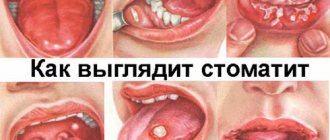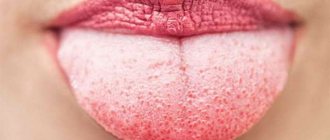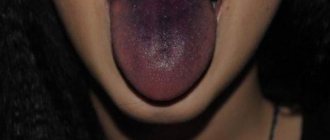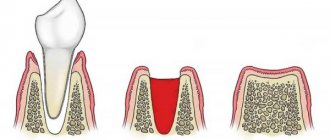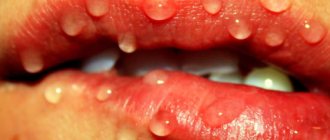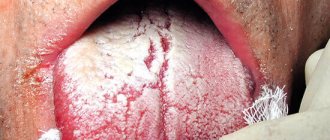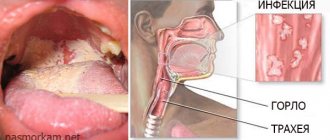Why does a white coating appear on the lips?
The causes of white plaque on the lips are non-pathological and pathological.
| Non-pathological causes | Possible diseases |
| Using low-quality lipstick (it contains components that contribute to the drying out of the epithelium and its peeling); unbalanced diet; uncontrolled use of antibacterial drugs; dysbacteriosis (the intestines or oral cavity suffer); abuse of alcohol-containing products; poor oral hygiene; use of dentures. | White plaque on the lips in adults is caused by: Infections; exacerbation of chronic pancreatitis; dental, endocrine pathologies (stomatitis, tonsillitis, gingivitis), gastrointestinal diseases. |
In adults
The natural cause of white plaque on the lips in the morning after sleep is the leakage of saliva. Characteristic spots form after it dries.
The pathological cause is the development of candidal stomatitis. It is caused by fungi of the Candida class. They are present in the body even in a healthy person, but they begin to multiply only against the background of weak immunity.
For the same reason, plaque appears in the corners of the lips or on the tongue in women during pregnancy. This also occurs against the background of hormonal changes.
Whitish discharge on the mucous membrane in men is caused by abuse of tobacco products. Less often - candidiasis. Discharge that occurs after a kiss may be due to an allergy to the cosmetics that the woman uses.
If the sticky plaque is accompanied by a feeling of dry mouth, then we are talking about the development of xerostomia.
It progresses against the background:
- dysfunction of the salivary glands;
- deficiency of vitamins A, B, E;
- neurological disorders;
- chronic mumps.
In children
The baby may develop a white coating on the inside of the lip or on the tongue.
Main reasons:
- weak immune system;
- improper child care;
- breathing problems;
- development of infectious pathologies.
Sometimes this reaction of the body is due to the beginning of the growth of the first teeth.
Pathological plaque
It’s a completely different matter when the white coating on the lips is thick or has a gray or brown color. This is already a sign of some kind of malfunction in the functioning of the body systems. To find out the causes of this symptom, it is necessary to consider the phenomenon in conjunction with other manifestations of the disease.
Thrush
Candida fungi are present in the body of any person, but they are activated only when immunity decreases caused by:
- long-term antibiotic therapy;
- chemotherapy;
- long-term use of hormonal drugs, including contraceptives;
- dysbacteriosis and some gastrointestinal diseases;
- HIV;
- during pregnancy.
In addition to a whitish coating, other characteristic symptoms may indicate thrush:
- pain, itching and burning in the mouth;
- difficulty swallowing;
- changes in taste sensations;
- frequent seizures in the corners of the mouth.
Candidiasis is an intractable and contagious disease; you need to try to get rid of it completely.
Stomatitis
This name includes all diseases of the oral cavity caused by bacteria and fungi. As a rule, with stomatitis, the patient experiences quite strong pain in the mouth when chewing. In addition to pain, stomatitis manifests itself:
- white coating, which is a clot of leukocytes;
- small red blisters on the surface of the mucous membrane, in place of which ulcers form;
- an increase in the number of leukocytes in the CBC;
- temperature increase.
Herpes
The manifestation of herpes infection in the form of plaque can easily be confused with stomatitis. The disease also causes long-healing ulcers in the mouth, seizures, itching and fever. Very often the subpharyngeal lymph nodes become enlarged.
Other reasons
The formation of a white film on the lips in the morning can also result from:
- Avitaminosis. The presence of vitamin deficiency may also be indicated by: peeling nails, hair loss, peeling skin.
- Prolonged prolonged stress.
- Gastrointestinal diseases: gastritis, ulcers, pancreatitis, dysbacteriosis. If plaque appears in the presence of painful sensations in the abdomen, belching, heartburn, you should consult a gastroeterologist.
- Endocrine diseases: diabetes, adrenal pathologies, autoimmune diseases.
Treatment course for cancer
How to treat white plaque on lips
First you need to see a doctor and determine the root cause. Then complex treatment is prescribed.
If the discharge was caused by Candida, antifungal therapy is prescribed. Additionally, the patient undertakes to take immunomodulatory drugs.
How to get rid of this symptom:
- Gently brush off the discharge with a soft brush.
- Pour 1 tsp. sage 200 ml boiling water. Leave for 40 minutes, filter well, cool. Use to rinse the mouth. Use immediately after waking up, before breakfast and brushing your teeth.
- Pour 2 tsp. yarrow 200 ml of boiling water. Place in a steam bath, wait 30 minutes. Filter, cool. Use to lubricate lips and rinse the mouth.
You can take antibacterial, antimycotic and antifungal drugs (Nystatin, Fluconazole, Nizoral) only as prescribed by a doctor.
Natural causes of plaque
In some cases, the phenomenon in question appears periodically and at different times of the day. In other situations, the problem is present on an ongoing basis. For example, a person may notice plaque in the morning after sleep, during which the saliva flowing from the mouth dries, forming a whitish crust. This condition passes through a certain period and should not cause alarm. But there are also dangerous pathologies that require immediate medical attention. We will list the most common provoking factors, and later in the material we will consider in more detail the main pathological causes.
- allergic reactions, which are caused, for example, by the use of toothpaste containing components that irritate the mucous membranes,
- vitamin deficiency associated with a lack of useful vitamins and microelements in the body - cracks appear in the corners of the lips, followed by a white coating,
- wearing uncomfortable or deformed orthopedic structures, which leads to injury to the mucous membrane and its drying out due, for example, to the inability to close the mouth normally,
- taking potent drugs, antibiotics, hormones and contraceptives, undergoing chemotherapy - all these factors can lead to changes in the composition of saliva and disruption of the protective functions of the oral mucosa,
- smoking and other bad habits - plaque in this case can be regarded as the first signal that it’s time to quit smoking and excessive alcohol consumption,
- dehydration of the body due to increased physical activity, as well as prolonged exposure to heat - dry mucous membranes lead to the appearance of small cracks around the lips and whitish discharge,
- problems with nasal breathing, due to which the mucous membrane often dries out, because you have to breathe through the mouth,
- prolonged depressive state - in such cases, the lower lip usually suffers mainly, on which, in addition to plaque, small pimples also appear. You need to reconsider your lifestyle, try to sleep at least 8 hours a day, or better yet, take a vacation from work and have a good rest, because the result of stress is not only plaque, but also other malfunctions in the internal systems of the body,
- poor nutrition, excessive consumption of salty, sweet, smoked, heavy and fatty foods, leading to problems such as dysbiosis, gastritis and other gastrointestinal disorders,
- systemic pathologies such as diabetes mellitus,
- viral and bacterial infections, which are most often caused by decreased immunity and poor oral hygiene.
Why do an adult or child's lips turn white?
The reasons for this phenomenon may be different for men and women of different ages. There are several main health problems that result in this symptom. Sometimes pale lips in an adult indicate overwork and chronic fatigue. In this case, the daily routine is normalized and more time is devoted to rest.
Anemia
When hemoglobin levels decrease, the blood becomes thin, causing the whole body to turn white. This condition is aggravated by dizziness, fainting, migraines and low blood pressure.
Anemia most often occurs due to a lack of vitamin B12 or iron. As a result, less hemoglobin is formed, which serves as a transporter of oxygen to the body's cells. Since the condition is chronic, only supportive therapy will help.
Heart diseases
Improper functioning of the cardiovascular system leads to impaired blood flow and lips turning pale. In advanced cases, a change in the color of all skin covers is observed. Heart disease is accompanied by fatigue, increased heart rate for no apparent reason, shortness of breath and chest pain.
If the symptoms described above suddenly appear, you should undergo a complete body check. The most common causes of heart disease are heredity, smoking, drinking alcohol, fatty foods, and stress. Limit yourself from these factors as much as possible and you will immediately feel an improvement in your condition and appearance.
Cyanosis
The disease is an oversaturation of the body with oxygen, as a result of which the tongue and lips acquire a white-blue tint, the skin loses its blush and becomes grayish, in the most severe cases, purple or black. The most common culprits for why cyanosis occurs are congenital heart disease, lung disease, cerebral edema, tetany (convulsions caused by a lack of calcium) or hyperphosphatemia (increased levels of phosphate in the blood).
This is a serious disease that requires professional treatment. If you notice a blue nasolabial triangle in yourself or your child, you should immediately call an ambulance. Unfortunately, this problem cannot be solved at home.
Thrush
Candidiasis or oral thrush occurs in many infants. This is due to immature immunity, especially if the baby is bottle-fed. At an older age, this is considered a serious pathology.
Thrush is easy to distinguish from other causes. The skin retains its natural color, but the lips become covered with a white coating. At the same time, it spreads to the mucous membranes of the mouth, tongue and throat. The patient may develop a cough, which can easily be confused with a cold. Thrush is treated with immune-strengthening procedures and antifungal agents.
Other reasons
Lips can become pale not only due to illness. In some cases this happens when:
- Vitamin deficiency.
- Vegetative-vascular dystonia.
- Constipation, when a large amount of toxins and waste accumulates.
- Pregnancy.
- Stomatitis.
- Fordyce disease, which manifests itself as white, subcutaneous, hard, round lesions. The problem is poorly understood and does not cause any inconvenience other than aesthetic ones.
- Lips may turn pale when a person is scared or cold. There is no need to worry, as the pallor goes away along with these feelings.
White plaque as a symptom of the disease
In medicine, there are several pathologies in which the accumulation of microbes on the lips is one of the main symptoms:
Stomatitis
With this disease, not only the lips, but also most of the oral mucosa (inner cheek area, palate and tongue) are covered with a white substance. Signs of stomatitis:
- redness of the affected area,
- the formation of ulcers, which may be purulent in nature,
- increased salivation,
- bleeding gums,
- burning and itching at the site of ulcer formation,
- feeling of pain when eating and talking,
- temperature increase,
- bad breath,
- In some forms of stomatitis, enlargement of the lymph nodes is possible.
The infection is transmitted by contact, so when a white coating appears, it is worth giving the person separate dishes and keeping the toothbrush away from the brushes of other family members.
The main causes of stomatitis are weakened immunity, insufficient hygiene and oral trauma.
Candidiasis
The disease is a fungal infection of the mucous membrane. These fungi of the genus Candida are always present in the human body, but with a decrease in the protective properties of the immune system, their numbers increase. During their reproduction, the intestinal, oral and vaginal mucosa of females becomes infected. Like stomatitis, candidiasis is transmitted by contact.
The disease is characterized by the following clinical picture:
- redness of the mouth
- cheesy coating, both on the oral mucosa and on the lips (in most cases on the lower). At the same time, cracks can often be seen on the surface of the lips,
- the formation of blisters at the beginning of the disease, in the place of which painful ulcers subsequently appear. They cause discomfort when eating and talking,
- burning and itching in the affected area,
- fast fatiguability,
- loss of appetite,
- If left untreated, the plaque becomes green or brown.
Candidiasis is dangerous due to such a complication as cheilitis, in which the curd clot abundantly covers the surface of the lips, and microcracks form on the mucous membrane due to its drying out.

